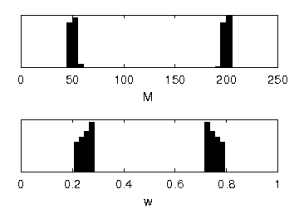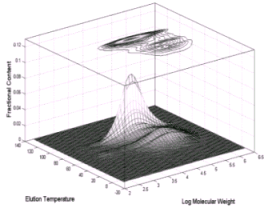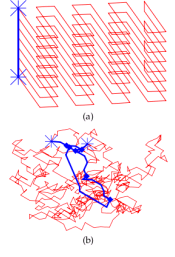SACHIN SHANBHAG |
 Shanbhag, S.; "Analytical rheology of blends of linear and star polymers using a Bayesian formulation", Rheol. Acta, 2010, 49(4), 411.
Shanbhag, S.; "Analytical rheology of blends of linear and star polymers using a Bayesian formulation", Rheol. Acta, 2010, 49(4), 411.
A Bayesian data analysis technique is presented as a general tool for inverting linear viscoelastic models of branched polymers. The proposed method takes rheological data of an unknown polymer sample as input, and provides a distribution of compositions and structures consistent with the rheology, as its output. It does so by converting the inverse problem of analytical rheology into a sampling problem, using the idea of Bayesian inference. A Markov chain Monte Carlo method with delayed rejection is proposed to sample the resulting posterior distribution. As an example, the method is applied to pure linear and star polymers, and linear-linear, star-star, and star-linear blends. It is able to (i) discriminate between pure and blend systems (ii) accurately predict the composition of the mixtures, in the absence of degenerate solutions, and (iii) describe multiple solutions, when more than one possible combination of constituents is consistent with the rheology. Online article |
 Subramanian, G.; Shanbhag, S.; "Conformational free energy of melts of ring-linear polymer blends", Phys. Rev. E, 2009, 80, 041806.
Subramanian, G.; Shanbhag, S.; "Conformational free energy of melts of ring-linear polymer blends", Phys. Rev. E, 2009, 80, 041806.
The conformational free energy of ring polymers in a blend of ring and linear polymers is investigated using the bond-fluctuation model. Previously established scaling relationships for the free energy of a ring polymer are shown to be valid only in the mean-field sense, and alternative functional forms are investigated. It is shown that it may be difficult to accurately express the total free energy of a ring polymer by a simple scaling argument, or in closed form. Online article |
 Vadlamudi, M.; Subramanian G.; Shanbhag, S.; Alamo R. G.; Varma-Nair M.; Fiscus D. M.; Brown G. M.; Lu C.; and Ruff C. J., "“Molecular Weight and Branching Distribution of a High Performance Metallocene Ethylene 1-Hexene Copolymer Film-Grade Resin", Macromol. Symp., 2009, 282(1), 1.
Vadlamudi, M.; Subramanian G.; Shanbhag, S.; Alamo R. G.; Varma-Nair M.; Fiscus D. M.; Brown G. M.; Lu C.; and Ruff C. J., "“Molecular Weight and Branching Distribution of a High Performance Metallocene Ethylene 1-Hexene Copolymer Film-Grade Resin", Macromol. Symp., 2009, 282(1), 1.
The bivariate, or cross branching distribution of a gas-phase produced, film-grade ethylene 1-hexene copolymer with enhanced Elmendorf tear in machine direction, MD, and in transverse direction, TD, (> 400 g/mil) and high dart impact has been characterized through the analysis of fractions obtained by molecular weight and 1-hexene composition. The molecular weight fractions, obtained by a solvent-non-solvent fractionation technique, are each mixtures of molecules with at least two different 1-hexene compositions, one component with a constant relatively high density (~1 mol% hexene) and a second of a lower density broadly distributed along the molecular weight fractions. The content of the low density component increases with increasing molecular weight of the fraction while the level of 1-hexene decreases. The mixed compositional character of these fractions is easily inferred by their high crystallization rates and both high melting and crystallization temperatures compared to the values of model random ethylene copolymers. The set of compositional fractions obtained by TREF display an increasing 1-hexene concentration with increasing molecular weight, and except for the highest molecular weight components (Mw > 150,000 g/mol) their melting and crystallization behavior followed the random pattern. Higher than expected melting temperatures and a constancy of the high melting temperature peak with increasing crystallization temperature, suggests that the intra-chain 1-hexene distribution of the highly branched, high molecular weight fraction deviates strongly from the random behavior. These structural features and the bimodal character of the composition distribution of this resin, that contains high molecular weight chains with both low and high 1-hexene contents, are correlated with the enhanced key film properties. Online article |
 Subramanian, G.; Shanbhag, S.; "On the Evolution of Entanglements in Initially Unentangled Polymer Melts", Int. J. Mult. Comp. Eng., 2009, 7(1), 1543.
Subramanian, G.; Shanbhag, S.; "On the Evolution of Entanglements in Initially Unentangled Polymer Melts", Int. J. Mult. Comp. Eng., 2009, 7(1), 1543.
The entanglement process in initially unentangled polymer chains with molecular weight greater than the entanglement molecular weight was examined using a modified bond fluctuation model. The relative roles of Rouse-like and reptation-like dynamics in the entanglement process were assessed. A scheme for fitting the time evolution of entanglement density was proposed and applied successfully to experimental data. The entanglement mechanism was elucidated by showing that at early times, the polymer chains preferentially develop entanglements away from their centers. Online article |
Back to Top
© 2008 Sachin Shanbhag
Last Modified: 10/01/2008
Last Modified: 10/01/2008

